Menus
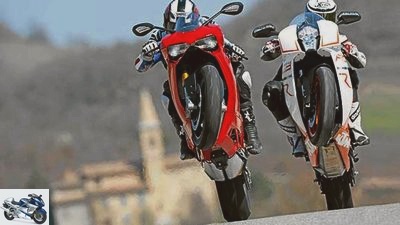
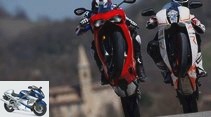
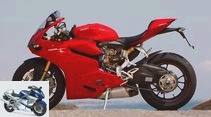
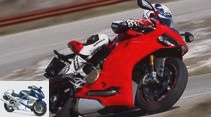
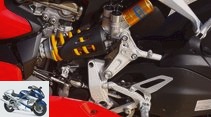
23 photos
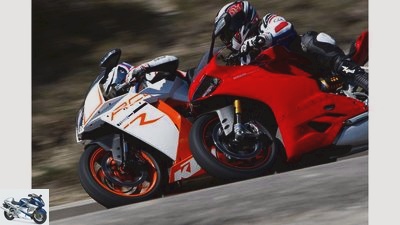
1/23
The two super sports two-cylinder, KTM RC8 R and Ducati 1199 Panigale S, in a comparison test. They are the last of the Mohicans – the last of their guild.
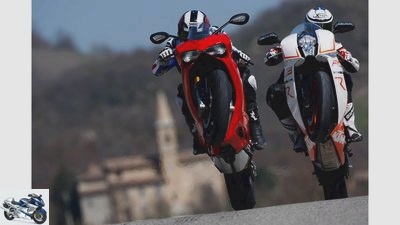
2/23
Ducati 1199 Panigale S and KTM RC8 R Wheelie.
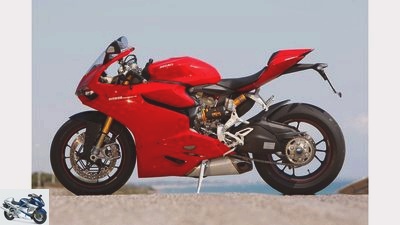
3/23
Ducati 1199 Panigale S..
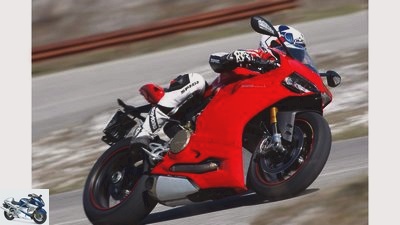
4/23
Ducati 1199 Panigale S..

5/23
Don’t go into the gravel! The complex redirection of the Ducati 1199 Panigale S lies unprotected on the left side of the vehicle.
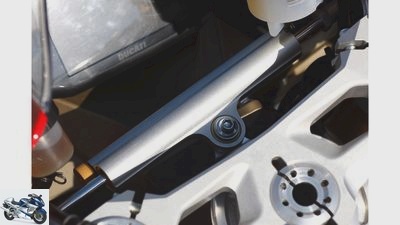
6/23
Ducati 1199 Panigale S: Only the steering damper can be adjusted manually.
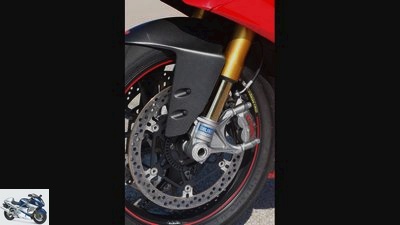
7/23
Currently the best on the market: the new Brembo M50 on the front of the 1199 S..
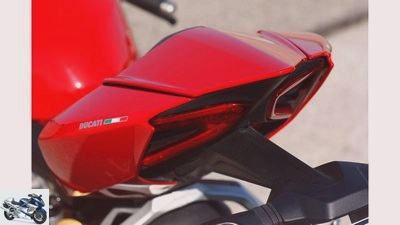
8/23
Chic LED rear light of the Panigale.
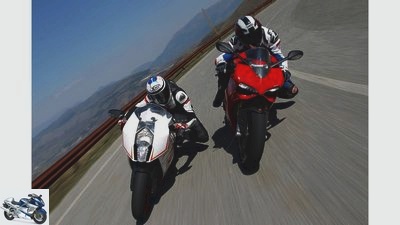
9/23
Burn baby, burn! KTM and Ducati in parallel flight. There has never been more twin enjoyment.
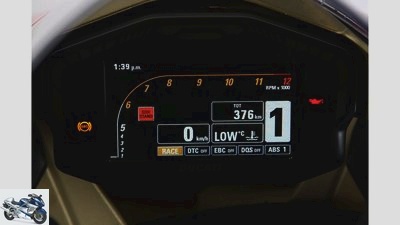
10/23
No other superbike currently offers more options for intervention and customization of the chassis and engine management than the Ducati Panigale S with its electrically adjustable damping system. Operation is via a switch on the left handlebar fitting and is easy to learn for anyone who can also use a mobile phone thanks to the logical menu navigation. State-of-the-art is called colloquially.
Here: Standard display with a large gear display and an easily readable rev counter.
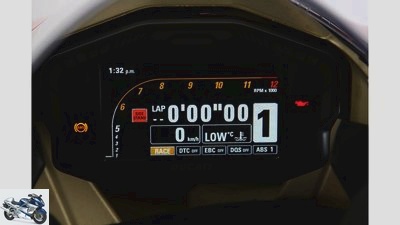
11/23
Ducati 1199 Panigale S: Dominant, activated lap timer. Off to the race to shoot and collect best times.
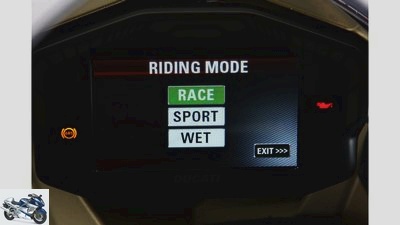
12/23
Ducati 1199 Panigale S: Menu level on which the three different driving modes can be selected.
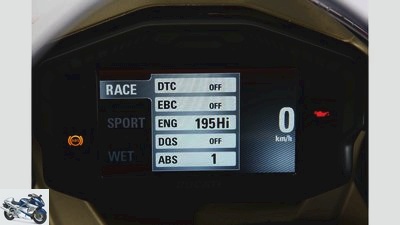
13/23
Ducati 1199 Panigale S: Overview level of the individual detailed settings of the various driving modes.
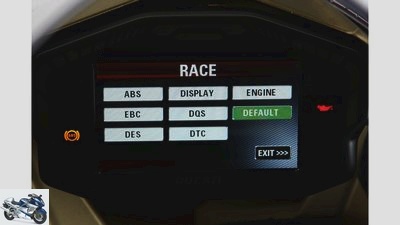
14/23
Ducati 1199 Panigale S: Customization level: Here almost everything can be set according to your own wishes.
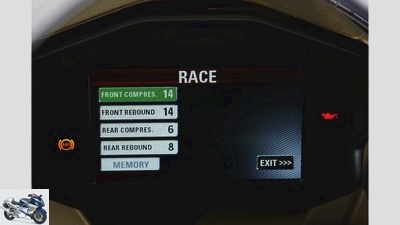
15/23
Ducati 1199 Panigale S: Overview of the current suspension settings on the fork and shock absorber.
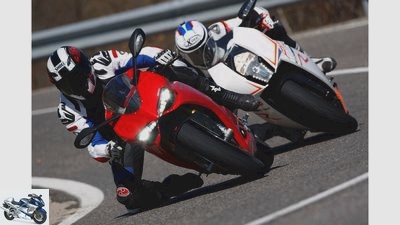
16/23
Ducati 1199 Panigale S and KTM RC8 R.
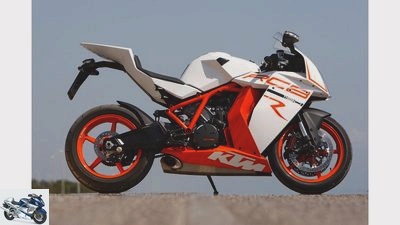
17/23
KTM RC8 R.
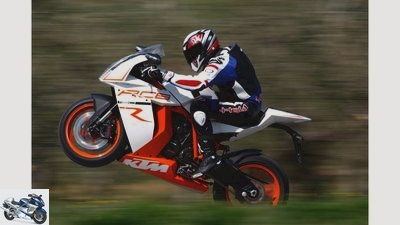
18/23
KTM RC8 R.
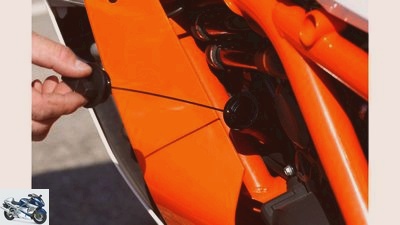
19/23
If you want to determine the correct oil level of an RC8 R, you must read and understand the manual.
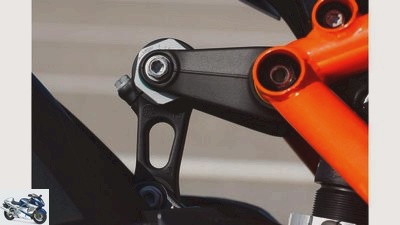
20/23
KTM RC8 R: Effective eccentric on the deflection.
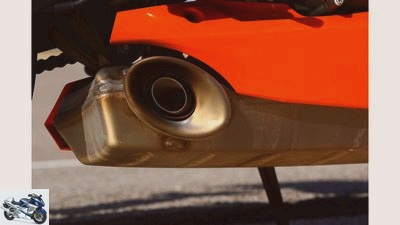
21/23
More efficient, not too loud rear silencer of the KTM RC8 R..
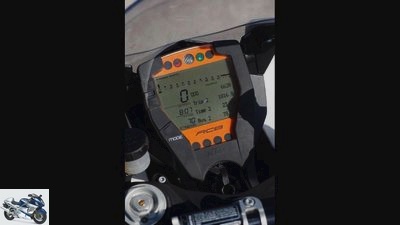
22/23
Informative instrument of the KTM RC8 R.
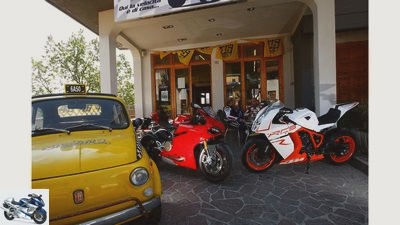
23/23
Mirror, mirror on the wall … Regardless of whether it is a Fiat 500, 1199 S or RC8 R – all three are very attractive.
Comparison test: Ducati 1199 Panigale S against KTM RC8 R
Superbike two-cylinder in direct comparison
Content of
They are the last of the Mohicans – the last of their guild. Ducati 1199 Panigale S and KTM RC8 R are the remaining superbike twins. Reason enough to let the completely different concepts compete against each other.
What a diversity there was! Aprilia RSV 1000, Ducati 916/996, Honda VTR 1000, Suzuki TL 1000 – all of them had a twin heart pulsing under the tight athlete’s disguise. And today? The former high-tech twins stand in the paddock like retired racehorses. Daring in overweight pseudo-enduros towards their death, like olle Klepper their way to the skinner.
But wait! Let’s remember this simple sentence: "Less is more". And yes, it is true. Better two twin racers with strong characters on the market than a whole stall full of bland, always similar four-cylinder superbikes! Hurray to Ducati 1199 Panigale S and KTM RC8 R, which impressively set themselves apart from the four-cylinder monocoque and, in addition to the Aprilia RSV4, add flavor to the superbike segment. And another hurray that the two twins are not like each other like eggs, but represent completely different philosophies when they reach their common goal, namely to be a fast superbike. Strictly speaking, one can even say that the KTM RC8 R is actually a classic but modern Du-cati with a steel space frame and so on, while the 1199 S is a modern, but with classic Ducati virtues, a superbike.
Old style
Need an explanation? With pleasure. The KTM RC8 R offers its user efficient adjustment options for the chassis and ergonomics. Level, damping, swing arm angle, handlebar height and offset, rear and footrest height, everything is mechanically adjustable. On the other hand, you won’t find any electronic helpers like ABS or TC – the KTM is classic in every respect. Ducati-like is its stiff and light tubular space frame, the twin with a big punch from a slightly increased idle speed and the stable driving behavior. The fact that KTM not only has classic mechanical expertise, but also has the electronics under control, has been proven by the engine management of the 1190 twin since 2011. Thanks to double ignition, the former rough leg has developed into a true model student. Its linear power delivery and the very good responsiveness inspire – the smoothness is at a decent level.
Subscribe to MOTORRAD videos on Youtube
Mirror, mirror on the wall … Regardless of whether it is a Fiat 500, 1199 S or RC8 R – all three are very attractive.
New style
And the Panigale? Well, it shows a glimpse into the future. Shows what is possible and what will most likely be state of affairs shortly. It is not just the chassis that can be adjusted with pure white gloves. No, the matter goes deeper. Much deeper. Starts with the three different driving modes "Race", "Sports" and "Wet" on, continues with the ABS modes, the adjustable engine braking torque, the eight-way adjustable traction control, the automatic gearshift and it culminates in the already mentioned electronically adjustable damping elements. The best news, however, is this: Even people who didn’t go to kindergarten with an iPad under their arm and learned to read with a book instead of a Kindle can use the Panigale’s electronics. The large, easy-to-read TFT display is forgiving of forgetting to wear reading glasses, and its operation via the left handlebar switch is even possible with osteoarthritis in the fingers. Ducati’s driver information display puts the very well-equipped KTM on-board computer in the shade in terms of legibility, as well as the amount and abundance of information. Will the Panigale also succeed in its entirety? If the revolutionary Kurzhuber takes the conservative Osi-Twin on the country road, nothing to me, nothing to clean up?
Style question 1
Not as usual in the northern Black Forest, but on Italian country roads. High-tech versus classic, monocoque versus steel corset, red versus orange. Both units wake up rumbling from sleep, feel comfortable in spring-like temperatures from the first crankshaft rotation and scratch their hooves expectantly. Holla the forest fairy, what’s that? The Panigale’s clutch disengages easily, just like that of the RC8 R, and its first gear engages with a quieter one "Klong" one than that of the Austrian! The first surprise is -perfect, even before the birds fly. – Restrained warming up of the engines follows – time to calibrate the Popometer sensors. The seating position on the Panigale is convincing. Gathered, sporty and comfortable, the pilot sits on the new Duc, and even has space on the bench to move back and forth. The KTM offers even more comfort and freedom. Completely relaxed and yet perfect for burning, she accommodates her chauffeur. It doesn’t pinch anything, it doesn’t pinch anywhere. "Va bene", says the Italian.
Attack! Engines, tires and drivers are at operating temperature, the winding country road invites you to swing in curves. The Panigale storms ahead cheekily, wants to show what it can do. The rhythm rises, and oops, the Duc is out of step. On the one hand, their throttle response is delayed, which does not correspond to their otherwise so direct nature. On the other hand, one looks in vain for the superior punch of an 1198. Now it’s gone, the torque tsunami that could so violently surf out of the corners. He was transformed – into top performance. Makes sense on the racetrack, but here on the country road? In numbers, the 1199 S lacks almost 30 Newton meters on the KTM at 6500 rpm! While the RC8 R has more than 120 Nm ready from 6500 tours up to the red area, the Duc only generates comparable forces around 8000 rpm. In the saddle there is clear disenchantment. Because the Panigale only wakes up at around 7000 rpm and then storms forward, however, mightily. The fat 1200 twin is a "Lathe operator", he craves high speeds.
Burn baby, burn! KTM and Ducati in parallel flight. There has never been more twin enjoyment.
The KTM looks more powerful, starts to overtake and dashes past the Ducati. Thanks to the linear power output, the juice of the 75-degree twin can be drawn off in a wonderfully dosed manner and transformed into propulsion stress-free. Especially on the country road, the superb responsiveness and the always controllable performance are really fun. From the apex of the curve to the next braking point, whatever the pilot orders is always delivered perfectly retrievable. No more and no less. However, the KTM switch box is less convincing when it comes to milling. Every now and then, unwanted idle runs creep in and force you to concentrate on the shift lever. The load change reactions of the RC8 R are also more pronounced than on the Duc.
But she articulates herself much more discreetly than the Italian. Whoever turns the 1199 S – and you have to do that to stay tuned to the KTM – lets it roar in a powerful voice. Another novelty about the Panigale is theirs "Seat heating". As early as spring, the waste heat from the bend of the rear cylinder curved under the seat hump is noticeable. Conspicuously inconspicuous, however, the Duc driving assistants hold back. With the TC at level 5 of 8 (8 intervenes early, 1 very late) and the ABS in moderate mode 3 (with lift-off detection of the rear wheel), it can be safely heated. There are almost no electronic interventions, which also speaks for the enormous grip level of the Ducati. The KTM shows how fast you can move forward without electronics. With the hustle and bustle with the 1199 S, you only wish for an ABS on very bad asphalt. However, the KTM Panigale will miss a slip on wet roads that echoes from Bologna to Mattighofen and back. When it comes to ABS and TC, it is high time KTM took action!
The RC8 R, on the other hand, is absolutely well positioned when it comes to the chassis. Very handy and precise, it can be thrown into the corners, hammers out of them neutrally and precisely and even digests interference from the driver while standing up and accelerating. The KTM simply seems to ignore bumps, edges and ruts and simply dampens them away. Only very hard edges penetrate the pilot’s backbone.
The Panigale sets new standards for Ducati conditions when it comes to handling, especially when it comes to quick flipping, but it still has to admit defeat in this discipline. The Austrian steers neutrally over the entire lean angle, while the Ducati looks stiff around the hips from a lean angle of around 20 degrees and more steering force has to be applied for further lean angles. In return, your Ohlins fork reports even more clearly from the ground than the WP counterpart of the KTM. However, unnecessary harshness reigns in the rear. Despite the fully open compression damping on the shock absorber, the Duc properly kicks its pilot in the back on bumps.
Ducati 1199 Panigale S and KTM RC8 R Wheelie.
Style question 2
There is no doubt that the Ducati 1199 Panigale S is a great motorcycle. Your technical equipment is top-notch and will remain so for some time. It has the most powerful twin on the market, but buys this power at the expense of a strong middle. While the KTM is a well-domesticated sports motorcycle suitable for everyday use, the Panigale S is definitely a road-legal racing motorcycle – with all its advantages and disadvantages.
PS rating / judgment
Ducati 1199 Panigale S and KTM RC8 R.
| Max. score | Ducati | KTM | drive |
| acceleration | 10 | 9 | 8th | Draft | 10 | 6th | 7th |
| Power delivery | 10 | 6th | 9 | Responsiveness | 10 | 6th | 10 |
| Load change reaction | 10 | 8th | 6th | Running culture | 10 | 7th | 7th |
| Gear actuation | 10 | 8th | 7th | Gear ratio | 10 | 8th | 9 |
| Clutch function | 10 | 8th | 8th | Traction control | 10 | 9 | – |
| Subtotal | 100 | 75 | 71 | landing gear |
| Driving stability | 10 | 7th | 7th | Handiness | 10 | 7th | 8th |
| Cornering stability | 10 | 9 | 9 | feedback | 10 | 8th | 8th |
| Suspension tuning in front | 10 | 9 | 9 | Chassis set-up at the rear | 10 | 6th | 8th |
| Braking effect | 10 | 10 | 9 | Brake metering | 10 | 10 | 9 |
| Righting moment when braking | 10 | 9 | 9 | ABS function | 10 | 10 | – |
| Subtotal | 100 | 85 | 76 | Everyday life + driving fun |
| Sitting position | 10 | 8th | 9 | Windbreak | 10 | 7th | 8th |
| Furnishing | 10 | 9 | 7th | consumption | 10 | 6th | 7th |
| Driving fun | 10 | 7th | 9 | Subtotal | 50 | 37 | 40 |
| Total | 250 | 197 | 187 | placement | 1. | 2. |
PS judgment
1. Ducati Panigale 1199 S.
Time for clear words: The Duc wins on points because of the ABS and the good traction control. The delayed response of the injection system, the very sharp engine character and the hard shock absorber are too extreme for the country road and cause more frustration than pleasure there.
2. KTM RC8 R
The almost perfect country road twin. The KTM makes life easy on the road, easy to ride and forgiving of mistakes. Only the inadequate safety equipment (ABS / TC) can and must be reprimanded.
Technical specifications
KTM RC8 R.
KTM 1190 RC8 R.
drive
Two-cylinder 75-degree V-engine, four valves / cylinder, 125 kW (170 PS) at 10 250 / min *, 123 Nm at 8000 / min *, 1195 cm³, bore / stroke: 105.0 / 69.0 mm, compression ratio: 13.5: 1, ignition / injection system, 52 mm throttle valves, hydraulically operated multi-disc oil bath clutch, six-speed gearbox, G-Kat, chain
landing gear
Steel tubular space frame, steering head angle: 66.7 degrees, caster: 96 mm, wheelbase: 1425 mm, upside-down fork, Ø fork inner tube: 43 mm, adjustable in spring base, rebound and compression. Central spring strut with deflection, adjustable in spring base, rebound and compression. Suspension travel front / rear: 120/120 mm
Wheels and brakes
Cast light alloy wheels, 3.50 x 17 / 6.00 x 17, front tires: 120/70 ZR 17, rear: 190/55 ZR 17, first tires: Dunlop Sportsmart, 320 mm double disc brakes with radially attached four-piston fixed calipers at the front, 220 mm -Individual disc with two-piston fixed caliper at the rear
measurements and weight
Length / width / height: 2050/830/1110 mm, seat / handlebar height: 810/880 mm, handlebar width: 665 mm, 204 kg with a full tank, v./h .: 52.8 / 47.2%
Rear wheel power in last gear
118 kW (160 PS) at 257 km / h
consumption
Fuel type: Super unleaded. Average test consumption: 6.0 liters / 100 km, tank capacity 16.5 liters, range: 275 km
Base price
16 295 euros (plus additional costs)
Ducati 1199 Panigale S..
Ducati 1199 Panigale S.
drive
Two-cylinder 90-degree V-engine, four valves / cylinder, 143 kW (195 PS) at 10 750 / min *, 132 Nm at 9000 / min *, 1198 cm³, bore / stroke: 112.0 / 60.8 mm, compression ratio: 12.5: 1, ignition / injection system, 67.5 mm throttle valves, hydraulically operated multi-disc oil bath anti-hopping clutch, six-speed gearbox, G-Kat, chain, traction control
landing gear
Load-bearing motor with light metal subframe, steering head angle: 65.5 degrees, caster: 100 mm, wheelbase: 1437 mm, upside-down fork, Ø fork inner tube: 43 mm, adjustable spring base, rebound and compression stage. Central spring strut with deflection, adjustable in spring base, rebound and compression. Suspension travel front / rear: 120/130 mm
Wheels and brakes
Forged light alloy wheels, 3.50 x 17 / 6.00 x 17, front tires: 120/70 ZR 17, rear: 200/55 ZR 17, first tires: Pirelli Supercorsa SP, 330 mm double disc brakes with radially attached four-piston fixed calipers at the front, 245- mm single disc with two-piston fixed caliper at the rear, C-ABS optional
measurements and weight
Length / width / height: 2060/810/1110 mm, seat / handlebar height: 820/850 mm, handlebar width: 670 mm, 195 kg fully fueled, v./h .: 52.5 / 47.5%
Rear wheel power in last gear
131 kW (178 PS) at 279 km / h
consumption
Fuel type: Super unleaded. Average test consumption: 6.6 liters / 100 km, tank capacity 17 liters, range: 258 km
Base price
24 490 euros (plus additional costs)
* Manufacturer information
Related articles
-
Ducati 999 S and Ducati 1199 Panigale S in comparison test
fact 14th photos fact 1/14 The rattling through the city with the Ducati 999 S is deep in the memory. But honestly, the current Ducati Panigale with the…
-
Ducati 1199 Panigale, EBR 1190 RX and KTM 1190 RC8 R.
Jahn 32 pictures Jahn 1/32 Cloud-free sky, glorious sunshine, the rumble of thunder: Three mighty V2 superbikes race down the slopes of Oschersleben …
-
Ducati Panigale, Ducati Multistrada, KTM RC8, KTM 1190 Adventure in the test
Kunstle 26 pictures 1/26 Ducati Multistrada 1200 S, Ducati 1199 Panigale S, KTM 1190 Adventure and KTM 1190 RC8 R in enduro / supersport bikes …
-
Ducati Panigale 899 and Suzuki GSX-R 750 in the test
fact 28 pictures fact 1/28 Tatort “Automotodrom Grobnik” near Rijeka, Croatia: On the historic racetrack, the brand new Ducati …
-
Super sports car Ducati 899 Panigale, Honda Fireblade SP Triumph Daytona 675 in the test
fact 31 photos fact 1/31 There are currently no brand new athletes. Some people therefore complain that nothing is moving anymore. Not correct! In the…
-
Comparison test: Ducati 1198 S against Ducati Multistrada 1200 S
Jahn comparison test: Ducati 1198 S against Ducati Multistrada 1200 S Ducati 1198 S against Ducati Multistrada 1200 S Content of One brand, one engine, two …
-
Ducati Monster 821 and Kawasaki Z 800 in comparison test
Bilski 34 pictures Bilski 1/34 Kawasaki Z 800. Bilski 2/34 Ducati Monster 821 and Kawasaki Z 800 in the comparison test. Bilski 3/34 Ducati Monster 821 and …
-
Comparison test Ducati Panigale V4 S and Ducati 1299 Panigale S.
factstudio.de 21 pictures factstudio.de 1/21 Ducati Panigale V4 S and Ducati 1299 Panigale S in a comparison test. factstudio.de 2/21 Two TFT displays ….
-
BMW HP4 and Ducati 1199 Panigale R in the test
49 photos 1/49 Exceptional in terms of performance and chassis: Ducati Panigale R and BMW HP4 in the test. 2/49…
-
BMW, Ducati, Suzuki and Triumph super sports cars in a comparison test
29 photos 1/29 Triumph Daytona 675, Ducati 848 Evo Corse SE, BMW S 1000 RR, Suzuki GSX-R 750. Different bikes – different cubic…